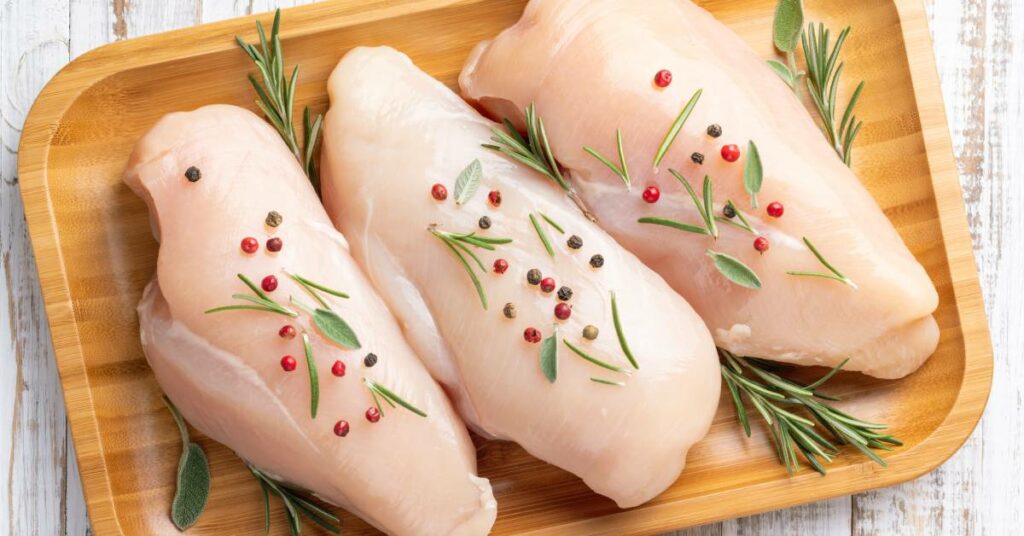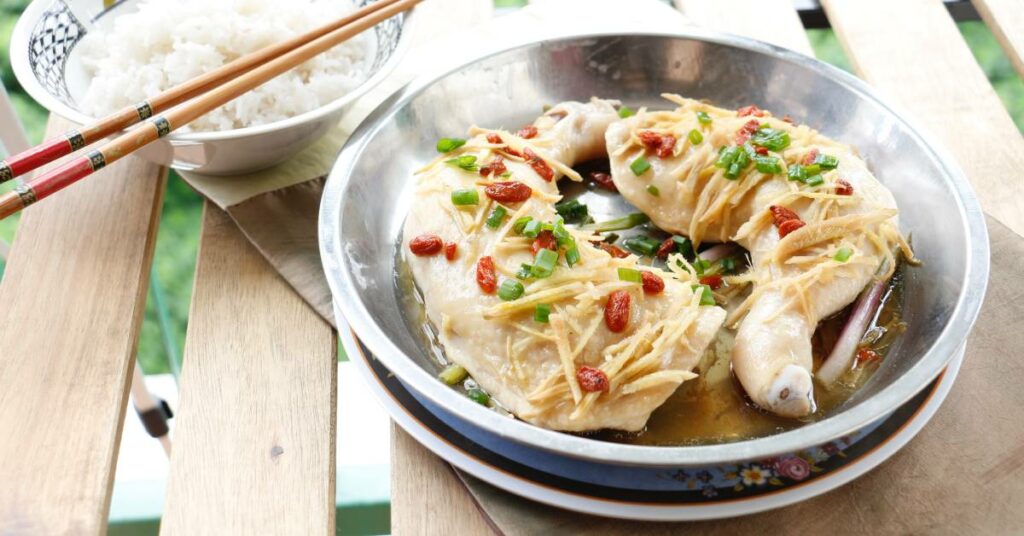Share the post "Why Is My Chicken Rubbery? (And How to Prevent)"
Chicken is simple to make with a lot of delicious recipes available on the internet. But there is a common question that everyone faces when trying their hand at these recipes: Why is my chicken rubbery?
Well, multiple reasons give a chicken a rubbery texture ranging from lack of moisture to overcooking and undercooking. Even if the chicken stays longer in the pan, oven, or grill than it should, it can get rubbery. Moreover, the type of chicken meat also can cause a rubbery texture.
Additionally, missing the proper cooking techniques can cause rubbery chicken also. So, there are a lot of reasons that cause rubbery chicken.
However, you do not have to get puzzled. In this article, we will discuss all those reasons for the rubbery texture of chicken and some of the easy remedies to say goodbye to this menace. Let’s roll it on!

Reasons Why My Chicken Is Rubbery
The Question, “Why is my chicken rubbery?” is not one to be answered in a line. We have already discussed that several reasons cause rubbery chicken, like lack of moisture, overcooking, undercooking, the type of the cut, etc. here we have discussed the causes elaborately:
Lack of Moisture
The chicken has low-fat properties, which causes the meat to turn dry soon. This moisture can dry off at any time. So any amount of moisture loss may result in it a rubbery texture.
The reasons for moisture loss can be overcooking, undercooking, and how you store your chicken. Sometimes it’s a woody chicken due to the age and genetics of a chicken to play a role.
Let’s look over each in detail.
Overcooking
Overcooking is the most common cause of moisture loss, resulting in hard-to-chew chicken. You may overcook while frying or baking.
When a chicken is overcooked, protein fibers lose moisture. Loss of moisture hardened the elastic chicken fibers due to exposure to high heat.
Tips to avoid Overcooked Chicken:
- Soak your rubbery chicken in the broth. Slice the chicken into thin pieces. Flood the chicken with the broth and place it in a preheated oven for 10 to 15 minutes at low temperature. Serve immediately.
- Additionally, you can compensate for its rubbery taste by bothering it with a moist and flavored sauce. You may opt for Alfredo sauce, Soy-based sauce, or a BBQ sauce.
Undercooking
Undercooked meat is rubbery in texture, but more importantly, it is also a severe health threat. You can avoid undercooking by measuring its temperature, and that must reach 165 F, to confirm that it is cooked entirely.
Tips to avoid undercooked chicken:
- Look out for the deepest part of the breast bone if any blood or uncooked meat is left near the bone.
- Using a meat thermometer, check the temperature of the deepest parts of the chicken, which must be at least 165 F. Proceed with cooking till the whole chicken catches that temperature all over.
Type of the Chicken Cut (Woody Breast Chicken)
The type of chicken cut is one of the reasons why it becomes rubbery. Like a woody breast, chicken sometimes has stiff muscle fibers and knotted texture. The debate goes on how and why there is a woody breast.
Some believe that age and genetics play a role, while many feel that organically grown chickens mostly have woody breasts. That imparts a rubbery chicken tendency upon cooking.
These chickens are not harmful to your health, but you may find them too chewy and rubbery for eating.
Tips to avoid woody chicken:
- Feel the breast of a chicken before buying it. See if it feels hard and lumpy under your fingers. Generally, a woody chicken breast feels harder than others, and it may also suffer from lumps.
White Stripes Over the Chicken
White Striping relates to a manner of wood grain impression across the surface of chicken breasts in the same direction as the grain of the muscle tissue.
It is the result of low-quality meat. White striping curtails nutritional value and taste. It makes chicken meat tougher and higher in fat.
However, the exact cause of white striping is not fully established, but some studies suggest the excessive amount of connective tissue as the main cause of rubbery texture. And new ways of raising chickens may have caused that.
LEARN MORE: Can You Eat Cold Chicken?
Is Rubbery Chicken Safe to Eat? (Possible Side Effects)
Having a rubbery chicken is an unpleasant dining experience. But if the robbery texture is due to overcooking or just because of a woody breast chicken, then it’s not harmful to consume.
Undercooked chicken may cause sickness, according to the Centre for Disease Control. There may be some bacteria left over in the chicken if it is undercooked. These bacteria may lead to food poisoning.
If you see the following symptoms, consult your doctor.
- A high fever
- Diarrhea
- Bloody stools
- Continuous vomiting
- A stomach pain.
How to Prevent Rubbery Chicken?
Now it’s time to look out for some super-easy solutions to overcome the rubbery texture of the chicken at your table.
Two things you need to do. Learn some cooking techniques and eye up the proper cooking time, and you are done! And the techniques are:
Frying
Your flame should be on high when you fry the poultry. This won’t let your chicken turn rubbery. But there is a catch. You need to cook all parts of a chicken evenly throughout.
Because cooking all small and big chicken parts may result in removing smaller parts earlier than the big ones. This may be hazardous to your health.
Due to the high likelihood of cross-contamination from the grease still includes chicken parts that are not wholly cooked. So how to fry it throughout? Pick up these tips!
- Make sure all parts of your chicken are cut out in similar sizes.
- Or cook larger and smaller parts individually.
- Or you may Cook larger parts early, as they will carry their heat and stay fresher longer while you cook the smaller parts meanwhile.
Baking
Harmful microbes can exist in undercooked chicken meat. The internal temperature of a chicken must reach 165 F to ensure that all potential health risks from such organisms have been eliminated by cooking.
When baked to the correct temperature for the right time, the chicken will be soft and moist.
If you bake at high temperatures that are too high, it will cause the water in the chicken to dry off and cause the chicken to be rubbery or spongy.
You can’t check it out just by observing the exterior skin here. You have to check it through a meat thermometer. Place the thermometer in the deepest part of the chicken and find out whether it has reached the right temperature.
Or you can observe the deepest part of your chicken for those red dots or Pink hues. If they are still there, you need to cook more.
Grilling
With grilling, you can have more maneuverability than any other cooking method. You can control the cooking temperature and areas to be cooked more and less over a wide grill surface. Can give separate times to each part of the chicken as per your desire.
However, still regulating the heat in a grill is not that easy, and you need to be careful of under and overcooking. How to manage that? Here are the tips!
- Be careful throughout the grilling process. Check on how the chicken is processing till it’s thoroughly cooked. It ensures that no part is either overcooked, undercooked, or burned. Because in either of the cases, you may get a rubbery chicken that is unpleasant to eat.
- Try barbeque sauce or beer to moisten chicken meat during grilling, and keep soaking the chicken in extra BBQ sauce if it gets dry due to grilling.
Boiling
We tend to boil chicken when it comes to preparing chicken soup. It may get overcooked even while cooking your chicken, causing rubbery chicken. What are the solutions to avoid that?
Make sure you have thin chicken slices boiled for about 15 to 20 minutes. You may take shreds and chicken cubes as well.
Cooking time and temperature depend on the type and volume of soup you are preparing and the ingredients put in with the chicken. Set your right time according to the elements you place in.
LEARN MORE: How to Tell if Frozen Chicken Is Bad?
Useful Pre and Post Cooking Tips to Avoid Rubbery Chicken

To ensure that your chicken does not go rubbery way post-cooking, here are the pre-cooking tips to follow:
- Cover the chicken with foil or plastic wrap if you are not cooking.
- Soaking the chicken in heavily salted water breaks the muscle fibers. Broken fibers make the meat tender and soft.
- It would be worth checking out the farming conditions in which the poultry was raised. Better fed chicken tends to have softer meat and fewer chances of a rubbery meat texture.
Conclusion
With all these tips and tricks, you are no longer going to ask why is my chicken rubbery?
So tell your friends and chicken lover how you make a soft and juicy chicken every time you have a tryst with your chicken.
Now you know how to cook the chicken like a pro and avoid possible side effects.
Show off your culinary skills!

